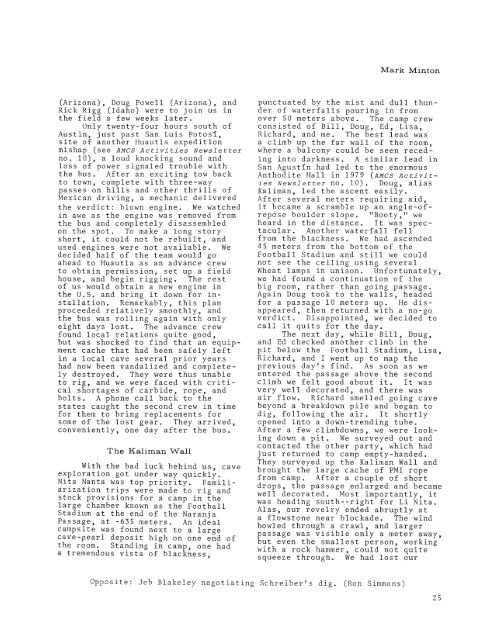7MB PDF - Association for Mexican Cave Studies
7MB PDF - Association for Mexican Cave Studies
7MB PDF - Association for Mexican Cave Studies
You also want an ePaper? Increase the reach of your titles
YUMPU automatically turns print PDFs into web optimized ePapers that Google loves.
(Arizona), Doug Powell (Arizona), and<br />
Rick Rigg (Idaho) were to join us in<br />
the field a few weeks later.<br />
Only twenty-four hours south of<br />
Austin, just past San Luis Potosi,<br />
site of another Huautla expedition<br />
mishap (see AMCS Activities Newsletter<br />
no. 10), a loud knocking sound and<br />
loss of power signaled trouble with<br />
the bus. After an exciting tow back<br />
to town, complete with three-way<br />
passes on hills and other thrills of<br />
<strong>Mexican</strong> driving, a mechanic delivered<br />
the verdict: blown engine. We watched<br />
in awe as the engine was removed from<br />
the bus and completely disassembled<br />
on the spot. To make a long story<br />
short, it could not be rebuilt, and<br />
used engines were not available. We<br />
decided half of the team would go<br />
ahead to Huautla as an advance crew<br />
to obtain permission, set up a field<br />
house, and begin rigging. The rest<br />
of us would obtain a new engine in<br />
the U.S. and bring it down <strong>for</strong> installation.<br />
Remarkably, this plan<br />
proceeded relatively smoothly, and<br />
the bus was rolling again with only<br />
eight days lost. The advance crew<br />
found local relations quite good,<br />
but was shocked to find that an equipment<br />
cache that had been safely left<br />
in a local cave several prior years<br />
had now been vandalized and completely<br />
destroyed. They were thus unable<br />
to rig, and we were faced with critical<br />
shortages of carbide, rope, and<br />
bolts. A phone call back to the<br />
states caught the second crew in time<br />
<strong>for</strong> them to bring replacements <strong>for</strong><br />
some of the lost gear. They arrived,<br />
conveniently, one day after the bus.<br />
The Kaliman Wall<br />
With the bad luck behind us, cave<br />
exploration got under way quickly.<br />
Nita Nanta was top priority. Familiarization<br />
trips were made to rig and<br />
stock provisions <strong>for</strong> a camp in the<br />
large chamber known as the Football<br />
Stadium at the end of the Naranja<br />
Passage, at -635 meters. An ideal<br />
campsite was found next to a large<br />
cave-pearl deposit high on one end of<br />
the room. Standing in camp, one had<br />
a tremendous vista of blackness,<br />
Mark Minton<br />
punctuated by the mist and dull thunder<br />
of waterfalls pouring in from<br />
over 50 meters above. The camp crew<br />
consisted of Bill, Doug, Ed, Lisa,<br />
Richard, and me. The best lead was<br />
a climb up the far wall of the room,<br />
where a balcony could be seen receding<br />
into darkness. A similar lead in<br />
San Agustin had led to the enormous<br />
Anthodite Hall in 1979 (AMCS Activities<br />
Newsletter no. 10). Doug, alias<br />
Kaliman, led the ascent easily.<br />
After several meters requiring aid,<br />
it became a scramble up an angle-ofrepose<br />
boulder slope. "Booty," we<br />
heard in the distance. It was spectacular.<br />
Another waterfall fell<br />
from the blackness. We had ascended<br />
45 meters from the bottom of the<br />
Football Stadium and still we could<br />
not see the ceiling using several<br />
Wheat lamps in unison. Un<strong>for</strong>tunately,<br />
we had found a continuation of the<br />
big room, rather than going passage.<br />
Again Doug took to the walls, headed<br />
<strong>for</strong> a passage 10 meters up. He disappeared,<br />
then returned with a no-go<br />
verdict. Disappointed, we decided to<br />
call it quits <strong>for</strong> the day.<br />
The next day, while Bill, Doug,<br />
and Ed checked another climb in the<br />
pit below the Football Stadium, Lisa,<br />
Richard, and I went up to map the<br />
previous day's find. As soon as we<br />
entered the passage above the second<br />
climb we felt good about it. It was<br />
very well decorated, and there was<br />
air flow. Richard smelled going cave<br />
beyond a breakdown pile and began to<br />
dig, following the air. It shortly<br />
opened into a down-trending tube.<br />
After a few climbdowns, we were looking<br />
down a pit. We surveyed out and<br />
contacted the other party, which had<br />
just returned to camp empty-handed.<br />
They surveyed up the Kaliman Wall and<br />
brought the large cache of PMI rope<br />
from camp. After a couple of short<br />
drops, the passage enlarged and became<br />
well decorated. Most importantly, it<br />
was heading south--right <strong>for</strong> Li Nita.<br />
Alas, our revelry ended abruptly at<br />
a flowstone near blockade. The wind<br />
howled through a crawl, and larger<br />
passage was visible only a meter away,<br />
but even the smallest person, working<br />
with a rock hammer, could not quite<br />
squeeze through. We had lost our<br />
Opposite: Jeb Blakeley negotiating Schreiber's dig. (Ron Simmons)<br />
25

















